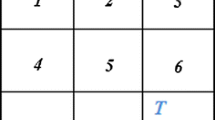Abstract
In this article, we present a unique search game model to search/hide an immobile object by/from a mobile sensor in a two-dimensional bounded space. In the proposed model, the mobile sensor is a searcher, the immobile object is a target and the search space is a square/rectangular region. The proposed model is suitable for the case where the searcher has no prior knowledge about the probability distribution of the target location in the region. The game model helps the players (searcher and target) to choose their best response strategies considering all possible strategies of their respective opponents and computes the expected payoffs and Nash Equilibrium of the game. The novelty of the proposed model is to guide both the players to choose their best response strategies. The proposed model is set up as follows: Initially, the search space which is a square/rectangular region is divided into square blocks of equal size to represent it as a grid and the distance is measured from the starting block of the searcher to all other blocks using shortest path followed by which the transition probabilities of each block is determined. Once the payoff matrix is obtained, we use lrslib tool to compute the mixed strategies, Nash equilibria and expected payoffs. The proposed model is applicable in real-time scenarios which involve large square/rectangular grids where the number of blocks is large.





Similar content being viewed by others
References
Hazra T, Kumar CRS, Nene MJ (2017) Strategies for searching targets using mobile sensors in defense scenarios. Int J Informat Technol Comp Sci 9(5):61–70
Shen S, Yue G, Cao Q, Yu FA (2011) Survey of game theory in wireless sensor networks security. J Netw 6:521–532
Shi HY, Wang WL, Kwok NM, Chen SY (2012) Game theory for wireless sensor networks: a survey. Sensors 12:9055–9097
Machado R, Tekinay S (2008) A survey of game-theoretic approaches in wireless sensor networks. Comput Netw 52:3047–3061 (Elsevier)
Das T, Roy S (2014) Game theory inspired mobile object trapping system in mobile wireless sensor network. In: International conference on electronic systems, signal processing and computing technologies, pp 245–250
Seda M, Brezina T (2009) Robot motion planning in eight directions. In: Proceedings of the world congress on engineering and computer science
Akewar MC, Thakur NV (2012) Grid based wireless mobile sensor network deployment with obstacle adaptability. Int J Wirel Mob Netw 4:21–34
Marzouqi MA (2011) Efficient path planning for searching a 2-D grid-based environment map. In: IEEE GCC conference and exhibition, pp 116–119
Akl R, Sawant U (2007) Grid-based coordinated routing in wireless sensor networks. In: 4th IEEE consumer communications and networking conference, pp 860–864
Alpern S, Lidbetter T (2013) Mining coal or finding terrorists: the expanding search paradigm. Oper Res 61:265–279
Gal S (2001) On the optimality of a simple strategy for searching graphs. Int J Game Theory 29:533–542
Lidbetter T (2013) Search games with multiple hidden objects. SIAM J Control Optim 51:3056–3074
Jotshi A, Batta R (2008) Search for an immobile entity on a network. Eur J Oper Res 191(2):347–359
Lidbetter T (2013) Search games for an immobile hider. In: Fokkink R et al (eds) Search theory: a game theoretic approach. Springer, Berlin, pp 17–27
Alpern S, Baston V, Gal S (2008) Network search games with immobile hider, without a designated searcher starting point. Int J Game Theory 37:281–302
Kiekintveld C, Jain M, Tsai J, Pita J, Ordóñez F, Tambe M (2009) Computing optimal randomized resource allocations for massive security games. In: International conference on autonomous agents and multiagent systems, pp 689–696
Tsai J, Yin Z, Kwak J, Kempe D, Kiekintveld C, Tambe M (2010) Urban security: game-theoretic resource allocation in networked physical domains. In: National conference on AAAI, pp 881–886
Hazra T, Kumar CRS, Nene MJ (2017) Modeling and analysis of grid-based target searching problems in a mobile sensor network. Wireless Pers Commun. doi:10.1007/s11277-017-4115-5
Hazra T, Nene MJ, Kumar CRS (2017) A strategic framework for searching mobile targets using mobile sensors. Wireless Pers Commun. doi:10.1007/s11277-017-4113-7
Hazra T, Nene M, Kumar CRS (2016) Optimal strategies for searching a mobile object using mobile sensors in a grid environment. In: 3rd ICACCS, Coimbatore
Savani R, Strengel BV (2014) Game theory explorer: software for the applied game theorist. Comput Manag Sci 12:5–33
Avis D, Rosenberg GD, Savani R, Stengel BV (2009) Enumeration of nash equilibria for two-player games. Econ Theory Symp 42:9–37
Avis D, Roumanis G (2013) A portable parallel implementation of the lrs vertex enumeration code. Comb Optim Appl LNCS 8287:414–429
Avis D (2000) lrs: a revised implementation of the reverse search vertex enumeration algorithm. In: Kalai G, Ziegler G (eds) Polytopes—combinatorics and computation, DMV seminar band, vol 29, pp 177–198
Avis D, lrslib, School of informatics. Kyoto University and School of Computer Science, McGill University
Acknowledgements
We are thankful to Dr. Debasish Pradhan, faculty member of Dept. of Applied Mathematics, DIAT and Ms. Monica Ravishankar, research scholar of Dept. of Computer Science And Engineering, DIAT for their valuable suggestions.
Author information
Authors and Affiliations
Corresponding author
Rights and permissions
About this article
Cite this article
Hazra, T., Nene, M. & Kumar, C.R.S. A probabilistic approach to compute strategies for players of a search game in a bounded space. CSIT 5, 305–313 (2017). https://doi.org/10.1007/s40012-017-0175-7
Received:
Accepted:
Published:
Issue Date:
DOI: https://doi.org/10.1007/s40012-017-0175-7




